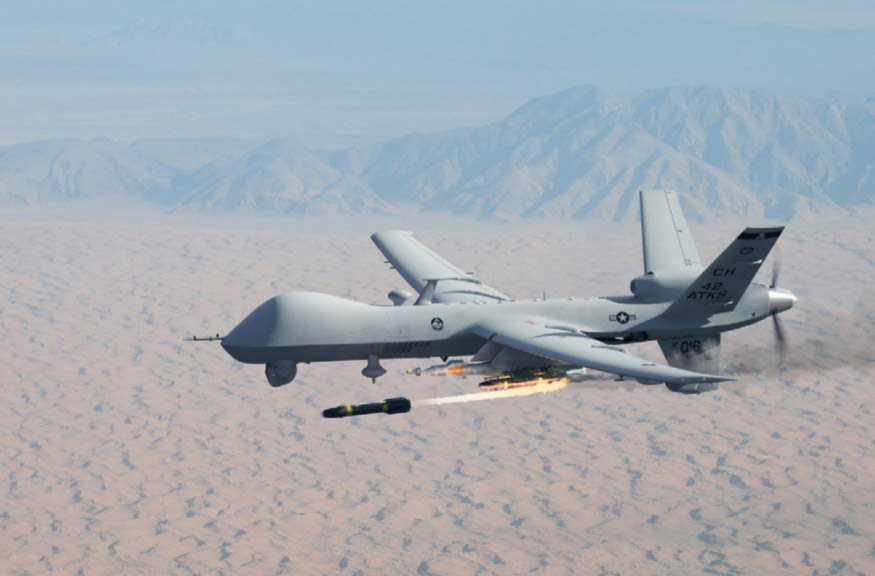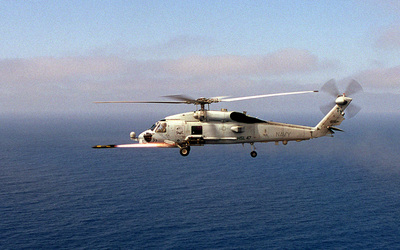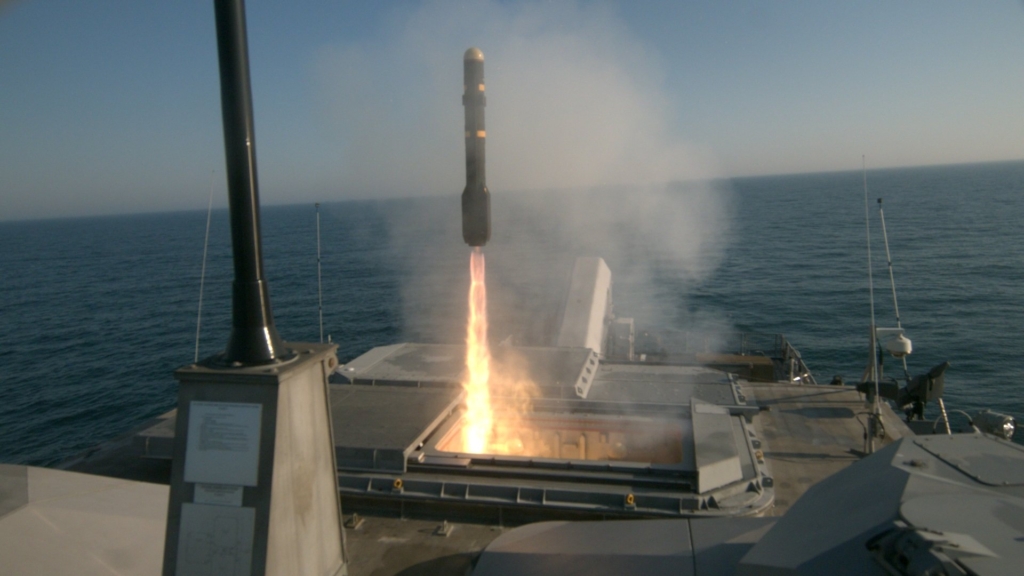The AGM-114 Hellfire is a short-range tactical missile in use by over two dozen countries. It is mostly used for land-attack missions and has seen widespread employment in the Global War on Terror. The Hellfire is predominately air-launched, although it has also seen limited deployment on sea platforms.
Hellfire at a Glance
- Originated From
- United States
- Class
- Air-to-surface missile (ASM)
- Length
- 1.62-1.75 m
- Diameter
- 0.178 m
- Launch Weight
- 45-48.5 kg
- Payload
- 8-11 kg
- Speed
- Subsonic
- Range
- 7-11 km
- Guidance
- Semi-active laser / Millimeter-wave radar guidance
- Status
- Operational
- Possessed By
- Australia, Bahrain, Croatia, Egypt, France, Greece, India, Indonesia, Iraq, Israel, Italy, Jordan, Kuwait, Lebanon, Norway, Pakistan, Qatar, South Korea, Saudi Arabia, Singapore, Spain, Sweden, Taiwan, Tunisia, Turkey, United Arab Emirates, United Kingdom, United States

An MQ-9 Reaper fires an AGM-114 Hellfire missile. Photo: U.S. Air Force 
A U.S. Navy SH-60 Seahawk helicopter fires a Hellfire missile. Photo: U.S. DoD 
USS Milwaukee (LCS-5) launches a Hellfire missile. Photo: U.S. Navy
Hellfire Development
The United States began developing the AGM-114 Hellfire in 1972 to address the Army’s requirement for a helicopter-launched antitank missile to counter Soviet armor formations. Soviet armor greatly outnumbered that of NATO and therefore posed a major threat in the event of a conventional conflict in Europe.1 The Marine Corps established a similar requirement and joined the Hellfire development program in 1978.2
Operational testing for the Hellfire ran between 1978-1981, and production began in 1982.3 The AGM-114A variant achieved initial operating capability with the U.S. Army in 1985, and entered service in April 1986.4
The missile was originally designated HELFIRE, or “HELiborne, Laser, FIRE and Forget Missile.” The U.S. Army later adopted the colloquial “Hellfire” as the official name.5
The Hellfire mission set has expanded significantly since its inception. Today the missile is used to target bunkers, radars, communications equipment, small buildings, fast-attack craft, and slow-moving or hovering helicopters.6 Hellfire capabilities have improved over decades of development, to tackle this wider range of targets, as well as to address countermeasures and obscurants and improve general mission efficacy.
The U.S. Army developed the AGM-114F in the early 1990s, for example, to counter new tank defenses. These defenses, known as “reactive armor,” explode when hit by an antitank missile to disperse the lethal charge meant to penetrate the tank.7 The AGM-114F was the first Hellfire missile to feature a tandem warhead, which consisted of two charges: one to set off the reactive armor, and a second to punch through the tank.
The United States also developed AGM-114K in the 1990s, the first of the so-called “Hellfire II” systems. Designed to improve lethality and operate better in a countermeasure or obscured environment, it featured several enhancements over previous models. These upgrades included a new digital autopilot, a larger warhead, an improved seeker, and reprogrammable software used to select different attack patterns in which to approach and strike its target.8 The “K” variant was also the first Hellfire capable of reacquiring its target after losing its laser lock.9 Later derivatives improved upon the missile’s warhead, first decreasing warhead sensitivity to prevent accidental detonation, and later adding a blast fragmentation sleeve to increase effectiveness against unarmored targets.10
Also entering the scene in the late 1990s was the AGM-114L, which featured greater autonomy and precision strike capabilities.11 Designated “Longbow,” the missile employs a millimeter-wave seeker instead of a semi-active laser, providing fire-and-forget capability and the ability to operate in poor weather conditions. It can engage moving and stationary targets.12 Flight testing began in 1994, and the missile first entered service in 1998.13
The AGM-114R “Romeo” was developed in the late 2000s to incorporate the various mission sets of prior Hellfire models. Its multimission “Integrated Blast Frag Sleeve” warhead is suitable against soft targets like small vessels or unarmored vehicles, or hard targets such as armed vehicles, bunkers and bridges, radar, and communications installations. Although the first Romeo models feature semi-active radar guidance, a subsequent development program aims to equip these missiles with millimeter-wave radar, as used in the “Longbow.”14 There are at least nine “Romeo” derivatives, each designed to incorporate new capabilities or facilitate foreign sales.15
Future Plans
The U.S. Navy has been testing the AGM-114L “Longbow” Hellfire aboard its Littoral Combat Ship (LCS) since 2014. The Hellfire would primarily serve to defend against small boats in swarm attacks.16 The Navy conducted initial live-fire tests in February 2017, and again in May 2018 and June 2019.17 According to a September 2019 report, LCS ships had test-fired around 79 Hellfires to date with a greater than 90 percent hit rate.18 The LCS has space for 24 Hellfire missiles in its Surface-to-Surface Mission Module (SSMM) vertical launch tubes. The U.S. Army and Marine Corps planned to replace the Hellfire with the AGM-169 Joint Common Missile (JCM), which began development in 1999.19 However, the Defense Department canceled the program in June 2007 after funding cuts brought on by operations in Iraq.20 The Services now plan to replace the Hellfire with the AGM-179 Joint Air-to-Ground Missile (JAGM), which began testing in 2012 and live-fire testing in FY 2017.21
Specifications
AGM-114 missiles measure between 1.63-1.75 m in length, 0.178 m in diameter, and weigh 45-48.5 kg. They have a range of 7-11 km while carrying a payload of 8-11 kg. The missile flies at subsonic speeds to a maximum of Mach 1.3 (450 m/s).22
Hellfire Variant Entered Service Notes AGM-114A 1986 First production model. AGM-114B 1986 Marine Corps model equipped with Safe and Arm Device (SAD) for shipboard use. Features improved low visibility capability, flying at lower altitudes and releasing less smoke than the AGM-114A. AGM-114C Late-1980s Army version of AGM-114B, but lacks SAD for shipboard use. AGM-114F 1993 Improved upon the AGM-114C. Features tandem warhead for use against reactive armor. It has a slightly larger airframe than previous Hellfire variants. AGM-114K 1996 First “Hellfire II” variant. Features new digital autopilot, a larger, tandem warhead, an improved seeker, and reprogrammable software tandem warhead and. This variant retargeting capability if the missile loses its laser lock on target. AGM-114L “Longbow” 1998 Features millimeter-wave radar guidance instead of a semi-active laser, providing fire-and-forget capability and the ability to operate in poor weather conditions. The Navy plans to equip this variant to its Littoral Combat Ship. AGM-114M 2000 Developed for the Navy. Features blast fragmentation warhead to target small vessels, including rigid inflatable boats, lightly armored vehicles, and other soft targets. AGM-114N 2005 Fitted with a thermobaric warhead to target infrastructure like bunkers and bridges, radar, and communications installations. AGM-114P 2007 Designed to equip high-flying unmanned aerial vehicles. Features improved field of view. AGM-114R “Romeo” 2012 Features a multimission warhead for use against all target sets (armored vehicles, hardened infrastructure, and soft targets). AGM-114R9X 2017 A derivative of the “Romeo” missile. Uses steel blades instead of a warhead to minimize civilian casualties in targeted killings.
Various U.S. platforms across the Services carry the AGM-114 missile. These include:
- Army’s AH-64 Apache helicopter, OH-58 Kiowa Warrior, AH-1W Super Cobra, AH-1Z Viper, MQ-1C Gray Eagle UAS, and Special Operations aircraft
- Navy’s SH-60B/HH-60H Seahawk
- Marine Corps’ KC-130J tanker and AH-1W Super Cobra
- Air Force’s MQ-1 Predator and MQ-9 Reaper UCAVs
Internationally, the Hellfire also equips Australia and France’s EC665 Tiger helicopter.23
The United States primarily employs the AGM-114 “Longbow” and “Romeo” today, due to their guidance and multimission capability, respectively.24 Foreign operators appear to use these variants as well as the earlier AGM-114K.25
“Knife Missile” Variant
In May 2019, the Wall Street Journal revealed the existence of a new AGM0-114 variant designed to minimize civilian casualties in targeted killings.26 Designated the R9X, it uses steel blades instead of an explosive warhead.” The R9X’s “danger-close” – or range at which non-combatants in the area are at risk – is reportedly a few feet.27 This compares favorably to the earlier Hellfire variants’ danger-close of over 100 meters.28 The AGM-R9X was used as early as February 2017 in Syria to kill al-Qaeda leader Abu Khayr al-Masri.29 It was subsequently used in targeted strikes against Jamal al-Badawi (Yemen, January 2019) and Khaled al-Aruri (Syria, June 2020).30
Hellfire Service History
The AGM-114A Hellfire missile entered service into the U.S. Army in April 1986.31 The United States has deployed the Hellfire missile in numerous combat operations. These include Operation Just Cause (Panama 1989), Operation Desert Storm/Shield (Iraq 1991), Operation Allied Force (Yugoslavia 1999), Operation Enduring Freedom (Afghanistan 2001), and Operation Iraqi Freedom (Iraq 2003), as well as various conflicts and targeted killings involved in the War on Terror. In 1999, the U.S. Air Force began a program to equip its unarmed, surveillance-focused MQ-1 Predator drone with the Hellfire.32 The Predator first flight-tested a Hellfire in January 2001 and fired one in combat in October 2001.33 The Predator/Hellfire (and subsequent Reaper/Hellfire) combination proved to be popular. Between 1998-2018, the Defense Department procured over 71,500 Hellfire missiles at the cost of $7.2 billion.34
In 1992, the Government Accountability Office (GAO) reviewed the missile’s performance during Operations Desert Storm and Desert Shield. The GAO found that AGM-114s fired between October 1990 and February 1991 had a 79 percent hit-rate—notably under the Army’s 90 percent requirement.35 The GAO has not conducted a publicly available assessment of Hellfire performance since, however, and only the older AGM-114A and -C missiles were used in Desert Storm and Desert Shield.36
Outside of the United States, operators include Australia, Bahrain, Croatia, Egypt, France, Greece, India, Indonesia, Iraq, Israel, Italy, Jordan, Kuwait, Lebanon, Norway, Pakistan, Qatar, South Korea, Saudi Arabia, Singapore, Spain, Sweden, Taiwan, Tunisia, Turkey, United Arab Emirates, and the United Kingdom.
Japan, Mexico, Morocco, the Netherlands, and Thailand have also expressed interest in procuring the missile.37
International operators have used the missile in counterinsurgency operations. France, for example, has employed Hellfire missiles against militant groups in Mali and Northern Africa.38 Iraq has also used Hellfire missiles against ISIS fighters within its territory.39
Footnotes
- Paul F. Gorman, “U.S. Intelligence and Soviet Armor,” CIA Brief, approved for release March 2004, https://www.cia.gov/library/readingroom/docs/DOC_0001066239.pdf; Walter E. Fischer, “Checking Soviet Armor’s Threat to NATO,” Heritage Foundation, March 17, 1988, http://s3.amazonaws.com/thf_media/1988/pdf/bg640.pdf.
- David Ewing and Malcolm Fuller, “AGM-114 Hellfire,” in IHS Jane’s Weapons: Naval 2016-2017 (United Kingdom: IHS, 2016), 129.
- “AGM-114 Hellfire,” Military-Today, https://www.military-today.com/missiles/hellfire.htm; “Army Weapons: Acquisition of Interim Improved Hellfire Missiles Not Justified,” Government Accountability Office, GAO/NSIAD-91-314, September 1991, https://www.gao.gov/assets/220/214851.pdf.
- Ewing and Fuller, “AGM-114 Hellfire,” 129.
- “AGM-114 Hellfire American Anti-Tank Guided Missile (ATGM),” U.S. Army Training and Doctrine Command, https://odin.tradoc.army.mil/mediawiki/index.php/AGM-114_Hellfire_American_Anti-Tank_Guided_Missile_(ATGM).
- Adam W. Lange, “Getting the Most from a Lethal Missile System,” Armor Magazine, January-February 1998, 26, https://static.dvidshub.net/media/pubs/pdf_33763.pdf.
- Malcolm W. Browne, “Threat to NATO Is Seen in Armor On Soviet Tanks,” New York Times, July 12, 1987, https://www.nytimes.com/1987/07/12/world/threat-to-nato-is-seen-in-armor-on-soviet-tanks.html.
- “Acquisition of Interim Improved Hellfire Missiles Not Justified, GAO; Andreas Parsch, “Boeing/Lockheed Martin (Rockwell/Martin Marietta) AGM-114 Hellfire,” designation-systems, http://www.designation-systems.net/dusrm/m-114.html.
- Lange, “Getting the Most from a Lethal Missile System,” 26.
- “The AGM-114K-2A Missile Enhanced Lethality Design and Test,” Navair (slide-deck), May 14-17, 2012, https://ndiastorage.blob.core.usgovcloudapi.net/ndia/2012/armaments/Tuesday13985gogley.pdf.
- “Longbow Hellfire,” Director, Operational Test and Evaluation, FY 2000, III-127 (p. 211), https://www.dote.osd.mil/Portals/97/pub/reports/FY2000/other/2000DOTEAnnRpt.pdf?ver=2019-11-13-183527-323.
- Ibid.
- designation-systems; “Longbow Hellfire,” Director, Operational Test and Evaluation, FY 2000, III-128.
- “AGM-114 Hellfire American Anti-Tank Guided Missile (ATGM),” U.S. Army TRADOC.
- “Calendar Year (CY) 2018 Transportation Costs Look Up Table Rates (DSCA 18-17) (SAMM E-Change 376),” Defense Security Cooperation Agency, March 13, 2018, https://www.samm.dsca.mil/policy-memoranda/dsca-18-17; Joseph Trevithick, “Secret Hellfire Missile With Sword-Like Blades Made Mysterious Strike On Terror Leader In Syria,” The Drive, May 9, 2019, https://www.thedrive.com/the-war-zone/27917/secret-hellfire-missile-with-sword-like-blades-made-mysterious-syria-strike-on-terror-leader.
- “FY16 Army Programs: Hellfire Romeo and Longbow,” Director, Operational Test and Evaluation, FY 2016, https://www.dote.osd.mil/Portals/97/pub/reports/FY2016/army/2016hellfire.pdf?ver=2019-08-22-105406-107.
- “Navy conducts successful missile test firing,” NAVSEA News, March 7, 2017, https://www.navsea.navy.mil/Media/News/Article/1104562/navy-conducts-successful-missile-test-firing/; Mark D. Faram, “LCS Milwaukee fires Longbow missiles in mission module test,” Navy Times, May 15, 2018, https://www.navytimes.com/news/your-navy/2018/05/15/lcs-milwaukee-fires-longbow-missiles-in-mission-module-test/; Xavier Vavasseur, “U.S. Navy Tests SSMM From Independence-Class LCS,” Naval News, July 27, 2019, https://www.navalnews.com/naval-news/2019/07/u-s-navy-tests-ssmm-from-independence-class-lcs/.
- Megan Eckstein, “The State of LCS: Navy Moving to Add Firepower, Capability to Both Classes,” USNI News, September 6, 2019, https://news.usni.org/2019/09/06/the-state-of-lcs-navy-moving-to-add-firepower-capability-to-both-classes.
- “Joint Air-to-Ground Missile Program,” U.S. Department of Defense Inspector General, December 7, 2017, i, https://media.defense.gov/2018/Apr/02/2001898073/-1/-1/1/DODIG-2018-038_REDACTED.PDF; John R. Hoehn, “Precision-Guided Munitions: Background and Issues for Congress,” Congressional Research Service, November 6, 2019, 17, https://www.everycrsreport.com/files/20191106_R45996_13011f7c229aedb19b19a2f0f563d472c5325188.pdf.
- “JAGM: Joint Air-Ground Missile Again,” Defense Industry Daily, last updated December 20, 2018, https://www.defenseindustrydaily.com/joint-common-missile-program-fired-but-not-forgotten-0229/.
- Hoehn, “Precision-Guided Munitions: Background and Issues for Congress,” 13; “FY17 Army Programs: Joint Air-to-Ground Missile (JAGM),” Director, Operational Test and Evaluation, FY 2017, https://www.dote.osd.mil/Portals/97/pub/reports/FY2017/army/2017jagm.pdf?ver=2019-08-19-113850-023.
- Jane’s Naval, 131; “Hellfire Family of Missiles,” U.S. Army Acquisition Support Center, last updated in 2020, https://asc.army.mil/web/portfolio-item/hellfire-family-of-missiles/; “AGM-114 Hellfire American Anti-Tank Guided Missile (ATGM),” U.S. Army TRADOC.
- “US Hellfire Missile Orders, FY 2011-2020,” Defense Industry Daily, last updated January 20, 2020, https://www.defenseindustrydaily.com/us-hellfire-missile-orders-fy-2011-2014-07019/.
- Ibid.
- This is based on DSCA Foreign Military Sales reports.
- Gordon Lubold and Warren P. Strobel, “Secret U.S. Missile Aims to Kill Only Terrorists, Not Nearby Civilians,” Wall Street Journal, May 9, 2019, https://www.wsj.com/articles/secret-u-s-missile-aims-to-kill-only-terrorists-not-nearby-civilians-11557403411.
- Kyle Mizokami, “The CIA’s Blade-Wielding ‘Flying Ginsu’ Missile Strikes Again,” Popular Mechanics, December 10, 2019, https://www.popularmechanics.com/military/weapons/a30175425/cia-blade-missile/.
- “FM 3-04: Army Aviation,” U.S. Army, July 2015, 104, https://fas.org/irp/doddir/army/fm3-04.pdf.
- Lubold and Strobel, “Secret U.S. Missile Aims to Kill Only Terrorists, Not Nearby Civilians.”
- Ibid.; Eric Schmitt, “U.S. Used Missile With Long Blades to Kill Qaeda Leader in Syria,” New York Times, June 24, 2020, https://www.nytimes.com/2020/06/24/world/middleeast/syria-qaeda-r9x-hellfire-missile.html.
- Ewing and Fuller, “AGM-114 Hellfire,” 129.
- Arthur Holland Michel, “How Rogue Techies Armed the Predator, Almost Stopped 9/11, and Accidentally Invented Remote War,” Wired Magazine, December 17, 2015, https://www.wired.com/2015/12/how-rogue-techies-armed-the-predator-almost-stopped-911-and-accidentally-invented-remote-war/.
- “Rover Summary,” presented at NDIA Conference, November 4, 2008, https://ndiastorage.blob.core.usgovcloudapi.net/ndia/2008/intell/Clark.pdf.
- Hoehn, “Precision-Guided Munitions: Background and Issues for Congress,” 18.
- “Operation Desert Shield/Desert Storm: Observations on the Performance of the Army’s Hellfire Missile,” GAO/NSIAD-92-156, Government Accountability Office, March 1992, https://www.gao.gov/assets/220/215705.pdf.
- Randy C. Nelson, “The Combat Use of Apache Helicopters in the Kuwaiti Theater of Operations: Effective or Not?” master’s thesis, U.S. Army Command and General Staff College, June 7, 1992, 12, https://apps.dtic.mil/dtic/tr/fulltext/u2/a258886.pdf.
- “Mexico – MH-60R Multi-Mission Helicopters,” Transmittal No: 18-06, Defense Security Cooperation Agency, April 19, 2018, https://www.dsca.mil/major-arms-sales/mexico-mh-60r-multi-mission-helicopters; “Morocco – AH-64E Helicopters,” Transmittal No: 19-63, Defense Security Cooperation Agency, November 20, 2019, https://www.dsca.mil/major-arms-sales/morocco-ah-64e-helicopters; “Thailand – AH-6i Helicopters,” Transmittal No: 19-62, Defense Security Cooperation Agency, September 24, 2019, https://www.dsca.mil/major-arms-sales/thailand-ah-6i-helicopters; Garrett Reim, “Lockheed Martin awarded $632m to make Hellfire II missiles for Netherlands and Japan,” Flight Global, October 2, 2018, https://www.flightglobal.com/helicopters/lockheed-martin-awarded-632m-to-make-hellfire-ii-missiles-for-netherlands-and-japan/129727.article.
- “The Government of France – Hellfire Missiles,” Transmittal No: 16-34, Defense Security Cooperation Agency, May 2, 2016, https://www.dsca.mil/major-arms-sales/government-france-hellfire-missiles-0.
- “The Government of Iraq – Hellfire Missiles and Captive Air Training Missiles,” Transmittal No: 15-64, Defense Security Cooperation Agency, January 7, 2016, https://www.dsca.mil/major-arms-sales/government-iraq-hellfire-missiles-and-captive-air-training-missiles.